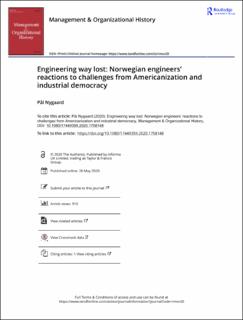| dc.contributor.author | Nygaard, Pål | |
| dc.date.accessioned | 2022-06-13T11:21:31Z | |
| dc.date.available | 2022-06-13T11:21:31Z | |
| dc.date.created | 2020-07-16T10:08:21Z | |
| dc.date.issued | 2020 | |
| dc.identifier.citation | Management & Organizational History, 2020, 15:3 | en_US |
| dc.identifier.issn | 1744-9359 | |
| dc.identifier.uri | https://hdl.handle.net/11250/2998505 | |
| dc.description.abstract | This article investigates how the Norwegian Engineering Association responded to challenges from Americanization and industrial democracy in the period from 1945 to 1980. This period was the heydays of the engineering way to top management positions in Norway. The engineering way was justified with reference to the engineers technical ‘Fachkompetenz’. As in many countries, Norway became subject for an institutional push toward Americanization of management the first decades after WW2. This process challenged the engineering way to management by propagating the need for management education. In Norway, there was not a smooth and swift process of Americanization of management and business. Rather, the Norwegian trajectory is a complex set of international and national influences and agendas. Primarily, Norwegian management practice was from the 1970s shaped by a political push for industrial democracy that was initiated by the Labor party and the labor movement in the 1960s. The process of introducing industrial democracy challenged both the traditional engineering way and the American way of making managers in Norway. This article unpacks how the Engineering Association responded to the challenges from Americanization and industrial democracy. | en_US |
| dc.language.iso | eng | en_US |
| dc.publisher | Taylor and Francis | en_US |
| dc.rights | Attribution-NonCommercial-NoDerivatives 4.0 Internasjonal | * |
| dc.rights.uri | http://creativecommons.org/licenses/by-nc-nd/4.0/deed.no | * |
| dc.title | Engineering way lost: Norwegian engineers’ reactions to challenges from Americanization and industrial democracy | en_US |
| dc.type | Journal article | en_US |
| dc.type | Peer reviewed | en_US |
| dc.description.version | publishedVersion | en_US |
| dc.rights.holder | The Authors | en_US |
| dc.source.pagenumber | 21 | en_US |
| dc.source.volume | 15 | en_US |
| dc.source.journal | Management & Organizational History | en_US |
| dc.source.issue | 3 | en_US |
| dc.identifier.doi | 10.1080/17449359.2020.1758148 | |
| dc.identifier.cristin | 1819553 | |
| cristin.ispublished | true | |
| cristin.fulltext | original | |
| cristin.qualitycode | 1 | |

